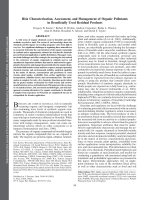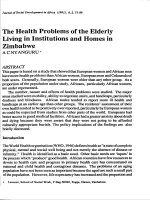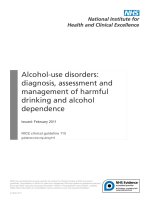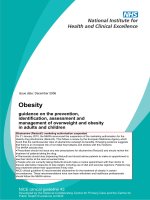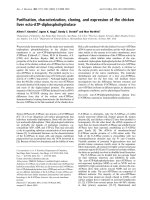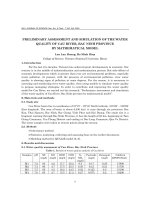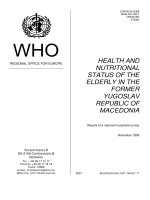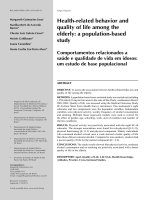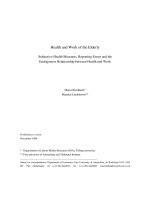Assessment and Management of the Elderly Patient with Multiple Sclerosis pot
Bạn đang xem bản rút gọn của tài liệu. Xem và tải ngay bản đầy đủ của tài liệu tại đây (471.5 KB, 11 trang )
Healthy Aging & Clinical Care in the Elderly 2012:4 1–11
doi: 10.4137/HACCE.S5166
This article is available from .
© the author(s), publisher and licensee Libertas Academica Ltd.
This is an open access article. Unrestricted non-commercial use is permitted provided the original work is properly cited.
OPEN ACCESS
Full open access to this and
thousands of other papers at
.
Healthy Aging & Clinical Care in the Elderly
EXPERT REVIEW
Healthy Aging & Clinical Care in the Elderly 2012:4 1
Assessment and Management of the Elderly Patient
with Multiple Sclerosis
Lyssa Sorkin
1
, Ivan Molton
2
, Kurt Johnson
3
, Amanda Smith
4
and Michelle Stern
5
1
Clinical Columbia University New York.
2
University of Washington Seattle, Washington.
3
University of Washington
Seattle, Washington.
4
University of Washington Seattle, Washington.
5
North Bronx Healthcare Network New York.
Corresponding author email:
Abstract: Multiple Sclerosis (MS) is a chronic and often disabling disease that is most often diagnosed in young adults. However, due
to better diagnostics and improved medical care, patients with MS have a normal life expectancy. This increase in longevity makes for
a change in the demographics of the disease, and clinicians must be prepared to meet the special medical and psychosocial needs of
the older MS population. Older patients present with increased medical complexity and require a comprehensive and multidisciplinary
approach. Understanding the challenges faced by aging MS patients can help the health care professional minimize morbidity and dis-
ability associated with this disease.
Keywords: multiple sclerosis, aging, disability, disease-modifying agents, pain, fatigue, depression, cognitive impairments, spasticity
Sorkin et al
2 Healthy Aging & Clinical Care in the Elderly 2012:4
Introduction
Multiple Sclerosis (MS) is the most common cause
of acquired neurological disability in young adults.
Historically, it is has been seen as a “young patient’s”
disease, as 70% of cases are diagnosed between the
ages of 20 and 40 years. The exact etiology of the
disease is not known, but current theories suggest that
MS is an inammatory autoimmune disorder with a
genetic and perhaps an environmental component.
Through medical advances in MS treatment made
over the past half century, many patients with MS can
now be expected to live well into older adulthood,
and as a result the demographics of this disease are
shifting. The purpose of this review is to provide a
summary of assessment, classication, and treat-
ment approaches for managing both the MS disease
process and associated conditions, and to discuss these
approaches in the context of the aging MS patient.
An Overview of MS in Aging
The hallmarks of MS are central nervous system
(CNS) inammation, demyelination, axonal degen-
eration and gliosis which can create a wide array of
brain and spinal cord syndromes. While MS is gener-
ally considered a chronic progressive illness, the tim-
ing and severity of progression is highly variable and
somewhat unpredictable. Major clinical manifesta-
tions of MS include sensory decits, weakness, visual
disturbances, cognitive impairment, depression,
spasticity, ataxia, heat intolerance, fatigue, pain, and
bowel and genitourinary dysfunction.
As the patient with MS ages, morbidities and
physiological changes associated with the normal
aging process interact with MS-related pathology to
inuence the severity of impairment and disability.
Symptoms associated with aging include fatigue,
sarcopenia, dynapenia, cognitive decline, and
physiological changes affecting the renal, liver and
cardiac systems. Older patient with MS have been
observed to have a faster rate of disease progression
leading to irreversible disability. Symptoms of MS,
such as weakness or fatigue, will be compounded
by age related changes including muscle atrophy
and reduced cardiopulmonary reserve. In addition,
older individuals are more sensitive to medication
side effects due to decreased ability to distribute
and eliminate metabolites. The risks and benets
of medication use in older adults with MS must be
carefully weighed. These synergistic effects of age
and neurological illness present a unique challenge
for the clinician and patient.
1–4
MS Classication
The diagnosis of MS is usually clinical and dened
by discrete neurological events separated in time. The
McDonald Criteria, which were revised in 2005 and
most recently in 2010, combine clinical presentation
with ndings on MRI that are characteristic of the
disease. The new criteria simplify the diagnostic
work-up and allow a more rapid diagnosis of MS
while maintaining the specicity and/or sensitivity
ultimately resulting in the need for fewer MRI
studies. Based on the revised criteria, the presence
of at least one T2 lesion in at least two of the four
locations considered characteristic of MS including
periventricular, juxtacortical, infratentorial and spinal
cord supports the diagnosis of disseminated in space.
To demonstrate the concept of disseminated in space,
a single scan that contains both gadolinium-enhancing
and non-enhancing lesions in regions typical for MS
qualies to make the diagnosis.
5
There are four major subtypes of MS that can
be characterized by their disease course: relapsing
remitting (RRMS), secondary progressive (SPMS),
progressive relapsing (PRMS) and primary progres-
sive (PPMS).
2,3,6,7
RRMS is diagnosed in 85% of patients on initial
diagnoses, and overall 55% have this subtype. Initially
in the disease, relapses occur with near recovery to
baseline and the patient is clinically stable between
episodes. However as the disease progresses, there
may be residual decits that accumulate over time.
Exacerbations can last days to weeks to months. The
longer a patient has MS, the greater the chance that
the relapses will be associated with residual decits
and increasing disability.
3,6,7
SPMS occurs in 30% of patients and is characterized
by gradual progression of disability with or without
superimposed relapses. If RRMS is left untreated,
50% of patients will develop SPMS in 10 years and
90% in 25 years. Whether this is due to increased
burden of disease over time or to decreased ability
for the nervous system to repair itself secondary to
aging requires further evaluation.
3,6,7
PPMS is dened by the gradual progression of
disability from onset without superimposed relapses.
Elderly patient with multiple sclerosis
Healthy Aging & Clinical Care in the Elderly 2012:4 3
This form occurs in 10% of the patients and is
most likely to have onset at an older age (40–
60 years of age) and fewer cognitive changes due
to primary involvement of the spinal cord. PRMS
is characterized by the gradual accumulation of
neurological decits from initial disease onset with
additional intermittent exacerbations.
3,6,7
Late onset MS (LOMS) classies patients who
are initially diagnosed after age 55. The prevalence
is 4.6%–9.4%.
8
These patients typically present with
motor impairments, tend to have a more progressive
course, and have a worse prognosis.
9
Diagnosing
LOMS is a challenge because it requires ruling
out other causes of chronic myelopathy, including
cerebrospinal vascular syndromes (CVA), hypertension
related disorders, compressive myelopathies,
primary or secondary vasculitis, metabolic disease,
and degenerative and nutritional syndromes. As a
result, diagnosis is often delayed due to low clinical
suspicion.
Assessment and Treatment in MS
When providing care for the patient with MS, one must
consider treating the disease process, acute exacerba-
tions, and the associated symptoms. Currently there
is no cure, but disease modifying agents are available
and can prolong independent functioning. The goal of
primary treatment is to reduce frequency and severity
of exacerbations.
Treatment with Disease-Modifying
Agents
Medications such as interferons and glatiramer acetate,
known as disease modifying agents, are used early
in patients with RRMS. The four currently available
interferons are Betaseron, Avonex, Rebif, and Extavia.
They are typically administered via an intramuscular or
subcutaneous injection. These medications have been
shown to decreased relapse rate. Side effects include
u like symptoms, injection site reaction, elevated
liver function tests (LFTs), and an abnormal complete
blood count (CBC). In addition, with frequent admin-
istration there may be an increased incidence of the
development of neutralizing antibodies resulting in
reduced efcacy of the medication.
10
Glatiramer acetate (Copaxane) is made up of four
amino acids, which form a collection of random
peptides designed to mimic myelin basic protein.
Side effects include injection site reaction and a
short-lived post-injection reaction characterized by
chest tightness, palpitations, ushing and anxiety.
10
Mitoxantrone is an anthracenedione, antineoplastic
agent that has been approved as therapy in patients
with secondary progressive, progressive relapsing and
worsening relapsing remitting MS. When used early,
it has been shown to decrease the number of relapses
and number of enhancing lesions as well as improve
the expanded disability status scale.
9
Common side
effects include transient leucopenia, elevated LFTS,
alopecia, bluish discoloration of urine and urinary tract
infections. More serious side effects include cardiac
and hematologic toxicity including cardiomyopathy
and acute leukemia respectively. Patients using
mitoxantrone require close cardiac monitoring
including echocardiograms prior to initiating therapy,
before administering each subsequent dose and yearly
after completing course of treatment. Patients should
also be followed by serial complete blood counts
looking mainly at the white blood cells prior and
following each dose. Side effects are dose related and
should not exceed 140 mg/m
2
.
11
Natalizumab (NTZ) (Tysabri), a humanized
monoclonal antibody, which binds to the alpha-4
beta1 integrins on leukocytes, reduces inammation
in the nervous system by preventing leukocytes
from crossing the blood brain barrier. It is used for
treating relapsing multiple sclerosis in patients with
an inadequate response to, or cannot tolerate other
therapies. It has been shown to reduce the risk of
disability progression and decrease the annual relapse
rate. However, most studies looking at NTZ as
monotherapy or in addition to interferon beta-1a were
done in patients ,55 years old. NTZ was initially
approved in 2004, but was withdrawn in February
2005 secondary to ten reported cases of progressive
multifocal leukoencephalopathy (a viral infection
of the brain that usually leads to death or severe
disability). However, after safety evaluation, it was
reapproved by the FDA in 2006. Due to the risk of
these dangerous side effects, the medication can only
be given through a special distribution program called
the TOUCH
TM
Prescribing Program. Other adverse
reactions include liver damage, allergic reaction,
fatigue, headaches and infections.
12
The efcacy,
tolerability and safety of NTZ was recently looked at
in a Cochrane review which demonstrated decreased
Sorkin et al
4 Healthy Aging & Clinical Care in the Elderly 2012:4
risk of exacerbations and progression of disease over
two years with good tolerability. Side effects include
infusion reactions, anxiety, sinus congestion, lower
limb swelling, rigors, vaginal inammation and
menstrual disorders.
13
Fingolimod (Gilenya) is a novel medication that
has recently received FDA approval and is currently
being used as rst line treatment of relapsing-
remitting and primary progressive MS. It is an oral
sphingosine-1-phosphate receptor modulator aimed
at inhibiting lymphocytes from leaving secondary
lymphoid organs thereby preventing them from
attacking myelin. It may also have neuroprotective
and reparative affects as well. It has been shown to
decrease relapse rate as well as disease activity. It is
an oral preparation and therefore older patients that
may have difculty with injections can take it with
ease leading to improved compliance. First dose side
effects include bradycardia, which peaks 6 hours
after dosing requiring close monitoring after initial
dose and symptomatic management. Other rst dose
side effects include headache, inuenza, diarrhea,
back pain, liver abnormalities and cough. Long-
term side effects include increased risk of infection,
macular edema, decreased pulmonary function and
hepatotoxicity.
14,15
Azathioprine (Imuran) and Cyclophasphamide
(Cytoxan) are both immunosuppressants used to slow
down the demyelinating process. The use of azathio-
prine as a treatment for MS remains controversial in
light of mixed research results. Side effects include
nausea, anemia, leukopenia, liver damage, and a
long-term increased risk of developing cancers such
as leukemia or lymphoma. This medication is less
likely to be tolerated in an older population and if
used may require long term monitoring for cancers.
Cyclophosphamide has shown only a modest benet.
It appears to be most effective in patients younger
than age 40 years, especially in those who have been
in the progressive phase for less than one year. The
duration of treatment is limited by the risk of blad-
der cancer, which appears to rise with time and may
depend upon the total accumulated drug dose.
10,16
Evaluation of the Older Patient
When evaluating older MS patients for treatment, it
is important to determine if new symptoms represent
progression or exacerbation of the underlying
disease or a separate underlying disease process.
This poses a unique challenge for the clinician, as
these symptoms often overlap. It is important to
have a high index of clinical suspicion and to order
the appropriate diagnostic tests in order to diagnose
and appropriately treat the underlying condition. For
example, consider an aging patient with MS who
presents reporting subjective declines in cognitive
functioning (in terms of mental processing speed
and word nding) as well as increases in spasticity
and fatigue. These symptoms could represent MS
disease progression, or could instead be related to
“aging” concerns such as cerebrovascular changes,
decreases in sleep efciency (perhaps secondary to
apnea) and declines in overall respiratory tness.
Likely, such symptoms reect an interaction of
MS and normative aging processes, and separating
such features diagnostically may prove impossible.
However, as always it is important to take a detailed
history to decipher the source of the symptoms and
to target treatments. A functional history is important
to determine how the disease process as well as the
aging may be affecting patient’s activities of daily
living and mobility.
Disease Modifying Agents
in Older Adults
Most studies that have evaluated these disease-
modifying agents have studied patients with a mean
age of 34–47, and have followed these patients for
only a few years. Very little work has examined the
effects of these medications on an aging population,
and more studies are needed to conrm long term
safety, efcacy and tolerability. For example, immu-
nosuppressants are mainly used for progressive MS,
but in the older population, the risks including medi-
cation side effects, cardiac toxicity and increased risk
for infection may outweigh the benets.
Treatment of Secondary Symptoms
in MS
MS is associated with a number of debilitating
symptoms, including pain, fatigue, depression and
cognitive dysfunction. These symptoms can have
a signicant negative impact on quality of life, and
can limit one’s ability to continue to participate in an
aggressive rehabilitation program.
Elderly patient with multiple sclerosis
Healthy Aging & Clinical Care in the Elderly 2012:4 5
Pain
Pain is one of the most common symptoms of MS
and can be seen in more than half of all patients with
MS. Pain can either be neuropathic or nociceptive.
Patients with MS may experience trigeminal
neuralgia, electric shock sensation radiating down
the spine or into limbs with neck exion (Lhermitte’s
sign), dysesthetic pain, back pain, visceral pain and
pain secondary to muscle spasms.
17
In the older
population, these pain conditions may interact with
other pain sources associated with normative aging
(eg, osteoarthritis, diabetic neuropathy). The initial
evaluation should determine if there is a physiologic
or structural reason for the pain that can be corrected.
Etiologies such as cervical and lumbar spondylosis
may occur in conjunction with MS, and MRI of
the cervical or lumbar spine should be part of the
diagnostic work-up.
18
Studies have shown that both MS patients and older
adults are often under-treated for pain, which can result in
increased morbidity.
19–21
Medications useful for treating
pain in this population includes opioid analgesics,
nonsteroidal anti-inammatory drugs (NSAIDS), anti-
seizure medication, antidepressants anti-spasticity
agents, and cannabinoids. An intrathecal pump may also
be benecial for pain secondary to spasticity. In older
adults, side effects of opioid class medications include
constipation, respiratory depression, confusion, and
lethargy. As a result, these analgesics must be prescribed
and monitored with care, and dose adjustments may be
necessary. The NSAIDS should be used with caution
in the elderly due to the increase risk of hypertension,
myocardial infarction, stroke, gastrointestinal bleeding,
and renal insufciency.
22
Carbemazapine and other
anticonvulsants may also increase confusion and ataxia
in the elderly. Tricyclic antidepressants (TCAs) or other
medications with anticholinergic effects may lead to
urinary retention, confusion, cardiac symptoms and
autonomic instability.
Much recent evidence emphasizes the importance
of a comprehensive, biopsychosocial model for
treating chronic pain. In addition to the medication
management approaches described above, a number
of psychosocial interventions exist and have shown
promising efcacy as adjunctive treatments for
chronic pain management. These include Cognitive-
Behavioral and Operant based psychological
interventions
23
as well as relaxation and
self-hypnosis training.
24
Generally, these approaches
teach patients to monitor their bodies for signs
of stress, to engage in deep breathing and other
stress management approaches, to evaluate their
thoughts and beliefs about pain, to challenge those
thoughts that are deemed alarming or not helpful
(eg, catastrophizing cognitions) and to develop
and reinforce thoughts that will contribute to better
outcomes. A recent meta-analysis of Cognitive-
Behavioral trials in chronic pain populations found
this intervention to be more efcacious than wait list
control conditions for decreasing difculties with
mood and interference with social role functioning,
as well as increasing positive cognitive coping and
activity level. Cognitive-behavioral treatments were
also found to have a signicant effect on reducing
subjective pain experience and overt pain behaviors
as compared to active treatment control conditions.
23
In theory, such approaches may be especially useful in
older adults, where side effects of medications make
purely pharmacological intervention impractical.
Only a handful of studies have evaluated
non-pharmacological pain interventions in MS
populations. In one recent pilot study of a cognitive
restructuring plus self-hypnosis training program in
adults with MS,
25
15 patients received 16 individual
treatment sessions. On average, daily pain intensity
was reduced 47% (from an average of 3.0 to 1.6 on a
0–10 numeric rating scale). Participants in this study
were on average 52.6 years of age, and no participant
was older than 65. There are to our knowledge no trials
of psychosocial interventions specically tailored for
older adults with MS-related chronic pain.
Fatigue
Another predominant symptom in MS is fatigue.
Fatigue is present in two thirds of patients with
one half describing fatigue as the most disabling
symptom.
26
Patients may refer to a “physical” or
“mental” fatigue. Common features of MS fatigue
include malaise, motor weakness during sustained
activity, and difculty maintaining concentration.
Again, a comprehensive assessment is required—an
aging MS patient who complains of fatigue should
be evaluated to rule out other potential causes,
including infection, cancer, anemia, hypothyroidism,
rheumatological disorders, sleep apnea and
diseases of the cardiovascular, pulmonary, renal or
Sorkin et al
6 Healthy Aging & Clinical Care in the Elderly 2012:4
hepatic system. Medications that can contribute to
fatigue include tricyclic antidepressants (TCAs),
selective serotonin reuptake inhibitors (SSRIs),
benzodiazepines, opioids, anticonvulsants, beta-
blockers, inteferons, and antispasticity medications.
Other factors that can lead to fatigue include
depression, pain, physical deconditioning, disrupted
sleep secondary to neurogenic bladder, and exposure
to a heated environment.
Once other causes have been ruled out, treatment
of fatigue includes energy conservation, initiation of
a regular exercise program, and (potentially) stimu-
lant medication. Aerobic exercises have in particu-
lar have been shown to be benecial in reducing
fatigue.
27
Medications include amantadine, modanil
and methylphenidate to improve arousal. Caution is
required when prescribing stimulants in older patients
due to poorer liver clearance and increased risk of
cardiac and cognitive side effects. Methylphenidate
has been associated with increased heart rate, but
has been shown to be safe and effective when looked
at adult populations with traumatic brain injuries.
28
Amantadine has been associated with an increased
risk of confusion and edema in the elderly.
26,29
Depression
Depression is the most common mood disorder
in MS, and affects more than half of all patients.
Incidence of depression in MS is three times higher
than the general population. Depressed affect may
certainly be associated with increasing disability and
restriction of valued activities, but it also likely that
depression in MS has an organic etiology related to
neural disruption. This observation is supported by the
fact that depression is more common in MS even as
compared to other disabling chronic disease states.
30
Depression may be overlooked, as there are symptoms
common to both such as fatigue, reduced activity,
decreased appetite, and poor concentration. MS is
associated with a 7.5 times higher suicide rate than in
the general population that cannot be explained fully
by a reactive depression.
31
Duration of MS, severity
of physical disability, and cognitive impairment do
not appear to affect the risk of suicide.
19,30–32
Depression may present differently in older
adults with MS. Generally speaking, rates of clinical
depression tend to decrease with age.
33
Prevalence
rates are 1%–3% in the general elderly population and
from 5%–17% in primary medical care settings.
34–37
Nevertheless, older adults are more likely than younger
adults to report subclinical symptoms of depression
(about 16% in the community),
33
or 29% in primary
care settings. When older adults do become depressed,
prognosis and impairment are worse compared to
younger persons. Studies have demonstrated overall
functioning that is comparable or worse than that
of people with heart and lung disease, diabetes, and
other serious chronic conditions.
38
Older patients may
also present with a cluster of symptoms including
anhedonia, lack of energy, and poor appetite, but little
description of tearfulness or overt sadness.
39
This
presentation has been called “depletion syndrome”
and “nondysphoric depression”.
40
Among clinically
depressed older adults undergoing treatment as usual,
at 24 months 33% are well, 33% remain depressed,
and 21% are deceased.
41
There are only a handful of studies of depression in
older adults with MS. Results generally reect nd-
ings from non-disabled populations—that is, older
adults with MS are at less risk of clinically signicant
depression than are younger adults with MS, but rates
remain higher than in the general population.
42,43
Treatment options for depression in older adults
include medication (generally, the SSRI class is rst
line, and Citalopram has shown good safety and
tolerability in older persons) and psychotherapy (with
greatest efcacy being demonstrated by cognitive-
behavioral and interpersonal therapy approaches).
Behavioral activation, engagement in pleasurable
activities, and physical activity are also key in
promoting a stable. Referral to a Rehabilitation
Psychologist is indicated if a patient fails to respond
to antidepressant medication, or more generally if
they request assistance with adjustment to disability.
Cognitive Impairment
Cognitive dysfunction can be seen in up to 50% of
patients with MS due to effects on the brain. Changes
in cognitive ability can signicantly impair one’s
ability to work and live independently. Although
mild cognitive dysfunction occurs frequently, only
5%–10% of patients will develop a severe cognitive
dysfunction.
19
Common cognitive decits include
problems in new memory acquisition and recall
(often experienced as a “loss of short-term memory”),
difculties with abstract reasoning, word nding, and
Elderly patient with multiple sclerosis
Healthy Aging & Clinical Care in the Elderly 2012:4 7
certain visuospatial functions, and slowness in the
speed of information processing information. General
fund of knowledge and receptive language skills are
generally unaffected. Decreased short-term memory
is the most common nding. Patients demonstrate
slowed retrieval of formed memories and often
require cueing. Aging itself causes homogeneous
cortical cell loss and some structural changes in the
frontal cortical-subcortical pathways, which can lead
to a slower learning rate and difculty with memory.
Thus, the aging MS patient may be at an even greater
risk for signicant cognitive disturbance.
The mini-mental examination may be useful in
tracking changes in cognition but it may be insensitive
to detect subtle cognitive changes occurring in most
MS patients. Full neuropsychological assessment is
indicated whenever possible to establish a baseline
and to monitor for long-term changes.
Additionally, medications should be assessed for
possible impact on cognitive function. Medications
that can contribute to cognitive slowing, especially
in the aging population, include anticholinergics,
antispasmodics, opioids, benzodiazepines, and TCAS.
Consideration should be given to change to long acting
anticholinergics preparations for bladder dysfunction.
The use of intrathecal medications or botulinum toxin
injections may be used to reduce high doses of oral
antispasticity agents. As always, it is important to
monitor for signs of depression, anxiety, or fatigue,
which may exacerbate cognitive difculties.
44–50
To manage cognitive changes associated with
MS, patients should be encouraged to use lists,
daily journals, and appointment books for activities.
Whenever possible, patients should also be seen by
a speech therapist or rehabilitation psychologist for
training in compensatory cognitive strategies.
Spasticity
MS patients also suffer due to spasticity and
increased tone seen with upper motor neuron lesions.
The presence of spasticity can lead to signicant
pain, impairments in function, and problems with
hygiene and positioning. Energy requirement for an
activity is increased with the presence of spasticity.
In the older patient, rule outs for increased spasticity
include secondary causes such as infections, skin
breakdown, or spinal stenosis with myelopathy. Oral
anti-spasticity medication may be poorly tolerated by
the older population and should be monitored closely.
Baclofen use in an elderly patient will require an initial
lower dose and a slower titration to decrease the risk of
sedation and confusion. Tizanidine should also be used
with caution in the elderly since clearance of the drug
is decreased four-fold. Monitoring for hypotension
and sedation is essential. The benzodiazepines are
traditionally poorly tolerated in the older population
and are associated with an increased half-life and a
higher association of paradoxical reactions, agitation,
and disequilibrium. An intrathecal baclofen pump may
be useful in patients with primarily lower extremity
spasticity.
19,51
Treatment of Functional Limitations
in MS
Gait disturbances due to muscle weakness, ataxia,
sensory loss and spasticity can result in impaired
mobility and increased risk for falls.
19
Assistive
mobility devices, including canes, crutches, walkers,
scooter, and manual or motorized wheelchairs
should be considered early to assist with mobility
and functional independence. A rolling walker
helps to conserve energy, and the addition of hand
brakes, a seat, and a basket can be benecial. It is
important to educate each patient on their needs and
how to utilize the assist device properly. As patients
age, their requirements may change and therefore a
falls assessment and mobility assessment should be
performed at each encounter.
Orthotics such as an ankle foot orthosis (AFO) may
be helpful in improving toe clearance in patients with
dorsiexion weakness. The ground force reaction
AFO can add knee stability without much additional
weight. Orthotics with high- energy demands such as
the hip-knee-ankle-foot orthosis should be avoided,
especially in the elderly MS patient. Wrist hand
orthosis are useful in the treatment of upper extremity
paresis and spasticity. Other equipment that may be
required for safety or for energy conservation include
bathtub benches, shower chairs grab bars, hoyer lifts
and stair lifts.
The use of even light weight self-propelled
wheelchairs can be difcult for MS patients, especially
as they age, and consideration should be given for a
motorized wheelchair. Before prescribing a motorized
wheelchair, the patient should be evaluated for decits
in cognition, vision, and manual dexterity which
Sorkin et al
8 Healthy Aging & Clinical Care in the Elderly 2012:4
can impair their ability to safely operate the device.
The safety of these devices needs to be reassessed
periodically as the disease progresses. Patients may
prefer a scooter to a motorized wheelchair, as there
is less associated perception of disability. However,
a scooter is not designed for prolonged seating and a
wheelchair will be more useful for those patients who
rely solely on motorized devices for mobility. Patients
with MS who have risk factors for a progressive
course should be compassionately advised to consider
wheelchair/handicap accessible housing as early as
possible.
52
Corticospinal tract involvement is present in
62% of patients with progressive disease. Typically
patients present with weakness, affecting the lower
extremities manifested by foot drop. To improve
ambulation, assistive devices such as canes and
walkers as well as orthotics can be used. Functional
electrical stimulation devices such as the Bioness
L300 or Walk Aide have been shown to improve
walking performance and may even have long lasting
effects due to neuroplastic changes.
11
A number of medications are aimed at treating
functional mobility decits associated with MS.
Dalfapridine (Ampyra) is a potassium channel blocker
that has showed promise in improving ambulation
in patients with walking disability due to MS. It
was approved in January 2010. A phase three,
placebo controlled trial looked at 237 patients from
39 centers in the US and Canada aged 18–70 years
with clinically dened MS. They found that patients
on the dalfampridine showed a 25% improvement in
walking speed based on the 25 foot walk test and the
drug was well tolerated. Adverse events seen in safety
and tolerability studies included ataxia, convulsions,
headache, chest pain and seizures.
53
In addition to medications, rehabilitation strategies
including physical therapy and exercise continue
to play an important role in the treatment of MS.
The primary goal is to maintain strength, mobility,
balance, range of motion and functional independence.
Exercise and core stability training have been shown
to help maintain balance and mobility in patients with
MS.
5
Furthermore, exercise can help counteract the
effects of disuse atrophy.
Given the potential implications of serious
falls, many older patients may develop a “fear
of falling” that can actually lead to restriction
of activities, decreased exercise, and behavioral
disengagement. This, paradoxically, can contribute
to general deconditioning and greater fall risk.
A comprehensive team based approach involving
joint sessions with a physical or occupational
therapist and a psychologist has been shown
effective in managing anxiety around falls and
associated restriction of activities.
Treatment of Comorbid Health
Conditions
As the patient with MS ages, they should always be
screened and evaluated for secondary conditions and
co-morbidities that are more common among the elderly,
including osteoporosis, osteoarthritis, diabetes, cardiac
disease, and cancer. Patients with MS are at increased
risk for osteoporosis due to the use of corticosteroids,
progressive immobility, vitamin D deciency and
age related bone changes. This loss of bone density,
combined with an increased fall risk (due to muscle
weakness, sensory decits, poor balance, and cognitive
and visual disturbances) likely contributes to a higher
frequency of bone fractures. In a USA MS registry,
27.2% of responders reported a low bone mass and
15% reported history of a fracture.
53
Hip bone mineral
density is more affected than vertebral bone mineral
density in patients with MS. There are currently no
clinical guidelines in the evaluation, prevention and
treatment of osteoporosis in MS patients.
53
The current
recommendations of screening the general population
for osteoporosis includes bone densitometry at the
age of 65 for women and 70 for men. However in
the MS population, screening should occur sooner if
the patient has been on equivalent doses of prednisone
5 mg for greater than three months or scores . 6 on
the Expanded Disability Status Scale (EDSS) as this
is associated with decreased bone mineral density and
increased risk of falls.
53
Diabetes mellitus type 2 has been shown to be
more prevalent in the MS population compared to the
general population.
54
Possible explanations for this
include muscle disease from nerve demyelination,
sedentary lifestyle, obesity and use of glucocorticoids
as treatment. Regular monitoring of fasting blood
glucose and hemoglobin A1C is indicated in older
MS patients. Chronic problems associated with
diabetes include microvascular complications such
as neuropathy, nephropathy and retinopathy, as well
Elderly patient with multiple sclerosis
Healthy Aging & Clinical Care in the Elderly 2012:4 9
as CVA and CAD. Many symptoms of diabetes can
overlap or mimic symptoms of MS. For example,
the neuropathy of diabetes consists of pain and
paresthesias beginning distally and spreading
proximally in a typical glove and stocking distribution.
Also, retinopathy can lead to visual disturbances such
as blurry vision, which are also seen in optic neuritis.
In patients who have MS and diabetes, treating an
acute exacerbation may pose a challenge secondary
to the negative effects high dose steroids have on
glycemic control. In this case very close monitoring
and medication adjustment is essential.
Osteoarthritis (OA) is common among patients
over 55 and a majority of patients over the age of
70 have some evidence of disease. Joints including the
knees, hips, spine, and hands are subject to degenera-
tive changes secondary to overuse and added stress.
Symptoms include pain, joint stiffness, and limited
range of motion all of which might reduce functional
mobility. Patients with MS may be at increased risk
for osteoarthritis because of additional stress placed
on joints secondary to weakness and spasticity. Most
cases of OA may be treated with conservative methods
including physical therapy, NSAIDS, intra-articular
steroids and/or viscosupplementation.
In some cases OA may warrant surgical
intervention. In the MS population, post-operatively,
patients have been found to develop hamstring spastic-
ity, which can lead to a exion deformity, resulting in
pain and decreased range of motion. This may require
additional therapy, bracing, muscle relaxants, or sub-
sequent surgery to perform hamstring release. Also, it
is important to realize that both general and regional
anesthesia have been implicated in MS relapses and
should be considered when deciding whether to pur-
sue surgical options.
55
Cancer is currently the second leading cause of
mortality in the US. In 2009, it is estimated that there
will be 1.5 million new cases of cancer diagnosed.
56
According to new studies, patients with MS have a
decreased overall cancer risk, however they are at a
higher risk for developing CNS or urological tumors.
The lower rates of digestive, respiratory, prostate and
ovarian cancer in MS patients may be secondary to
lifestyle changes associated with their illness, immu-
nological changes due to disease activity or treatment
effects. There has been some evidence of an increased
breast cancer risk in women with MS treated with
immunosuppressive therapy, but this is still under
investigation.
57,58
The increased risk for bladder
cancer may result from chronic bladder inammation
in the setting of urological dysfunction.
57
There is an increased risk of brain cancer in MS
patients, presumably due to the chronic neurologic
inammation that accompanies the disease. However,
patients with MS are imaged frequently and the
increased risk may reect an increase in detection.
Although patients with MS may have a lower
risk of cancer than the general population, they still
require general screening tests such as annual mam-
mograms for women over 40 (with no risk factors),
colonoscopy or exible sigmoidoscopy in men and
women after 50, and prostate specic antigen (PSA)
levels in men over 50.
Conclusion
MS is a chronic, progressive neurological disease that
contributes to signicant morbidity and disability.
Modern disease modifying approaches mean that
most patients with MS are expected to live a normal
lifespan. This, in conjunction with a general “graying”
of the US population, means that the demographics of
the MS patient are shifting. MS may typically present
in young adulthood, but it can no longer be seen as
a “young patient’s” disease. As the patient with MS
ages, medical complexity increases. It becomes both
more important—and more difcult—to differentiate
between exacerbations, progression of the disease,
normal physiological aging and disease processes
associated with the elderly. Initiating proper diagnostic
workup and evaluation along with appropriate
treatment strategies are essential to improve quality
of life. Although studies looking at older patients
with MS are becoming more prevalent, much more
research is needed, especially regarding the long term
effects disease modifying agents and medications for
symptom management. Although there is no current
cure for MS, the medical team can play a key role in
helping the patient and family adapt to this illness and
maintain quality of life.
Acknowledegments
This worked was support in part by funding from the
US. Department of Education National Institute on
Disability and Rehabilitation Research, Rehabilitation
Research and Training Center on Physical Disability
Sorkin et al
10 Healthy Aging & Clinical Care in the Elderly 2012:4
and Aging, grant number H133B080024 and
Rehabilitation Research and Training Center on
Multiple Sclerosis, grant number H133B080025
at the University of Washington Department of
Rehabilitation Medicine.
Disclosures
Author(s) have provided signed conrmations to the
publisher of their compliance with all applicable legal
and ethical obligations in respect to declaration of
conicts of interest, funding, authorship and contrib-
utorship, and compliance with ethical requirements
in respect to treatment of human and animal test
subjects. If this article contains identiable human
subject(s) author(s) were required to supply signed
patient consent prior to publication. Author(s) have
conrmed that the published article is unique and not
under consideration nor published by any other pub-
lication and that they have consent to reproduce any
copyrighted material. The peer reviewers declared no
conicts of interest.
References
1. Williams R, Rigby AS, Airey M, Robinson M, Ford H. Multiple sclerosis: Its
epidemiological, genetic, and health care impact. J Epidemiol Community
Health. Dec 1995;49(6):563–9.
2. Frohman EM. Multiple sclerosis. Med Clin North Am. Jul 2003;87(4):867–97,
viii–ix.
3. Hauser S, Goodkin D. Multiple sclerosis and other demyelinating diseases.
In: Braunwald E, Fauci A, Kasper D, Hauser S, editors. Harrison’s Principles
of Internal Medicine. 15 ed. New York: McGraw-Hill; 2001:1096–133.
4. Trojano M, Liguori M, Bosco Zimatore G, et al. Age-related disability in
multiple sclerosis. Annals of Neurology. Apr 2002;51(4):475–80.
5. Polman CH, Reingold SC, Banwell B, et al. Diagnostic criteria for multiple
sclerosis: 2010 revisions to the McDonald criteria. Annals of Neurology.
Feb 2011;69(2):292–302.
6. Lublin FD, Reingold SC. Dening the clinical course of multiple sclerosis:
Results of an international survey. National multiple sclerosis society (USA)
advisory committee on clinical trials of new agents in multiple sclerosis.
Neurology. Apr 1996;46(4):907–11.
7. Joy J, Johnston R. Clinical and biological features. Multiple Sclerosis Current
Status and Strategies for the Future. Washington DC: National Academy
Press; 2001:29–114.
8. Bermel RA, Rae-Grant AD, Fox RJ. Diagnosing multiple sclerosis at a
later age: more than just progressive myelopathy. Mult Scler. Nov 2010;
16(11):1335–40.
9. Cocco E, Marchi P, Sardu C, et al. Mitoxantrone treatment in patients with
early relapsing-remitting multiple sclerosis. Mult Scler. Sep 2007;13(8):
975–80.
10. Noseworthy JH. Management of multiple sclerosis: Current trials and future
options. Curr Opin Neurol. Jun 2003;16(3):289–97.
11. Le Page E, Leray E, Edan G. Long-term safety prole of mitoxantrone in a
French cohort of 802 multiple sclerosis patients: a 5-year prospective study.
Mult Scler. Jul 2011;17(7):867–75.
12. O’Connor P. Natalizumab and the role of alpha 4-integrin antagonism in
the treatment of multiple sclerosis. Expert Opin Biol Ther. Jan 2007;7(1):
123–36.
13. Pucci E, Giuliani G, Solari A, et al. Natalizumab for relapsing remitting
multiple sclerosis. Cochrane Database Syst Rev. 2011;10:CD007621.
14. Horga A, Castillo J, Montalban X. Fingolimod for relapsing multiple
sclerosis: An update. Expert Opin Pharmacother. May 2010;11(7):
1183–96.
15. Kappos L, Radue EW, O’Connor P, et al. A placebo-controlled trial
of oral ngolimod in relapsing multiple sclerosis. N Engl J Med. Feb 4,
2010;362(5):387–401.
16. Galetta SL, Markowitz C, Lee AG. Immunomodulatory agents for the treat-
ment of relapsing multiple sclerosis: A systematic review. Arch Intern Med.
Oct 28, 2002;162(19):2161–9.
17. Solaro C, Brichetto G, Amato MP, et al. The prevalence of pain in
multiple sclerosis: A multicenter cross-sectional study. Neurology. Sep 14,
2004;63(5):919–21.
18. Bashir K, Hadley MN, Whitaker JN. Surgery for spinal cord compression in
multiple sclerosis. Curr Opin Neurol. Dec 2001;14(6):765–9.
19. Cobble N, Miller E. Aging with multiple sclerosis. In: Felsenthal G,
Garrison S, Steinberg F, editors. Rehabilitation of the Aging and Elderly
Patient. Philadelphia: Williams and Wilkins; 1994:427–39.
20. Ehde DM, Jensen MP, Engel JM, Turner JA, Hoffman AJ, Cardenas DD.
Chronic pain secondary to disability: A review. Clin J Pain. Jan–Feb 2003;
19(1):3–17.
21. Jeffrey D. Pain and dysthesia. In: Burks J, Johnson K, editors. Multiple
Sclerosis: Diagnosis, Medical Management, and Rehabilitation. New York:
Demos; 2000:425–31.
22. Boop W. Pain management in the geriatric patient. In: Maloney F, Means K,
editors. Physical Medicine and Rehabilitation: State of the Art Review:
Rehabilitation and the Aging Population. Vol. 4. Philadelphia: Hanley &
Belfus; 1990:83–92.
23. Morley S, Eccleston C, Williams A. Systematic review and meta-analysis of
randomized controlled trials of cognitive behaviour therapy and behaviour
therapy for chronic pain in adults, excluding headache. Pain. Mar 1999;
80(1–2):1–13.
24. Jensen MP, Barber J, Romano JM, et al. A comparison of self-hypnosis versus
progressive muscle relaxation in patients with multiple sclerosis and chronic
pain. Int J Clin Exp Hypn. Apr 2009;57(2):198–221.
25. Jensen MP, Ehde DM, Gertz KJ, et al. Effects of self-hypnosis training and
cognitive restructuring on daily pain intensity and catastrophizing in individ-
uals with multiple sclerosis and chronic pain. Int J Clin Exp Hypn. Jan 2011;
59(1):45–63.
26. Krupp LB. Fatigue in multiple sclerosis: Denition, pathophysiology and
treatment. CNS Drugs. 2003;17(4):225–34.
27. Mostert S, Kesselring J. Effects of a short-term exercise training program on
aerobic tness, fatigue, health perception and activity level of subjects with
multiple sclerosis. Mult Scler. Apr 2002;8(2):161–8.
28. Willmott C, Ponsford J, Olver J, Ponsford M. Safety of methylphenidate fol-
lowing traumatic brain injury: Impact on vital signs and side-effects during
inpatient rehabilitation. J Rehabil Med. Jun 2009;41(7):585–7.
29. Fisk JD, Pontefract A, Ritvo PG, Archibald CJ, Murray TJ. The impact of
fatigue on patients with multiple sclerosis. Can J Neurol Sci. Feb 1994;
21(1):9–14.
30. Minden S, Frumin M, Erb J. Treatment of disorders of mood and affect
in multiple sclerosis. Multiple sclerosis therapeutics. New York: Martin
Dunitz; 2003:651–89.
31. Sadovnick AD, Eisen K, Ebers GC, Paty DW. Cause of death in patients
attending multiple sclerosis clinics. Neurology. Aug 1991;41(8):1193–6.
32. Feinstein A. An examination of suicidal intent in patients with multiple
sclerosis. Neurology. Sep 10, 2002;59(5):674–8.
33. Kasl-Godley JE, Gatz M, Fiske A. Depression and depressive symptoms
in old age. In: Nordhus IH, VandenBos GR, Berg S, Fromholt P, editors.
Clinical Geropsychology. Washington, DC: American Psychological
Association; 1998:211–7.
34. Cole MG, Yaffe MJ. Pathway to psychiatric care of the elderly with
depression. Int J Geriatr Psych. Feb 1996;11(2):157–61.
35. Bland RC, Newman SC, Orn H. Epidemiology of psychiatric disorders in
Edmonton. Acta Psychiatr Scand Suppl. 1988;338(77):1–80.
Publish with Libertas Academica and
every scientist working in your eld can
read your article
“I would like to say that this is the most author-friendly
editing process I have experienced in over 150
publications. Thank you most sincerely.”
“The communication between your staff and me has
been terric. Whenever progress is made with the
manuscript, I receive notice. Quite honestly, I’ve
never had such complete communication with a
journal.”
“LA is different, and hopefully represents a kind of
scientic publication machinery that removes the
hurdles from free ow of scientic thought.”
Your paper will be:
• Available to your entire community
free of charge
• Fairly and quickly peer reviewed
• Yours! You retain copyright
Elderly patient with multiple sclerosis
Healthy Aging & Clinical Care in the Elderly 2012:4 11
36. Friedhoff AJ, Ballenger J, Bellack AS, et al. NIH Consensus Development
Panel on Depression in Late Life. Diagnosis and treatment of depression in
late life. JAMA. Aug 26, 1992;268(8):1018–24.
37. van Marwijk H, Hoeksema HL, Hermans J, Kaptein AA, Mulder JD.
Prevalence of depressive symptoms and depressive disorder in primary care
patients over 65 years of age. Fam Pract. Mar 1994;11(1):80–4.
38. Wells KB, Burnam MA. Caring for depression in America: Lessons
learned from early ndings of the medical outcomes study. Psychiatr Med.
1991;9(4):503–19.
39. Caine ED, Lyness JM, King DA, Connors BA. Clinical and etiological
heterogeneity of mood disorders in elderly patients. In: Schneider LS,
Reynolds CF, Lebowitz BD, Friedhoff AJ, editors. Diagnosis and Treatment
of Depression in Late Life: Results of the NIH Consensus Development
Conference. Washington DC: American Psychiatric Press; 1994:23–53.
40. Newmann JP, Engel RJ, Jensen JE. Age differences in depressive symptom
experiences. J Gerontol. Sep 1991;46(5):P224–35.
41. Cole MG, Bellavance F, Mansour A. Prognosis of depression in elderly
community and primary care populations: A systematic review and
meta-analysis. Am J Psychiatry. Aug 1999;156(8):1182–9.
42. Chwastiak L, Ehde DM, Gibbons LE, Sullivan M, Bowen JD, Kraft GH.
Depressive symptoms and severity of illness in multiple sclerosis:
Epidemiologic study of a large community sample. Am J Psychiatry. Nov 2002;
159(11):1862–8.
43. Patten SB, Metz LM, Reimer MA. Biopsychosocial correlates of life-
time major depression in a multiple sclerosis population. Mult Scler.
Apr 2000;6(2):115–20.
44. Rao SM. Neuropsychology of multiple sclerosis. Curr Opin Neurol. Jun 1995;
8(3):216–20.
45. Bobholz JA, Rao SM. Cognitive dysfunction in multiple sclerosis: A review
of recent developments. Curr Opin Neurol. Jun 2003;16(3):283–8.
46. Rao SM, Hammeke TA, McQuillen MP, Khatri BO, Lloyd D. Memory
disturbance in chronic progressive multiple sclerosis. Arch Neurol. Jun 1984;
41(6):625–31.
47. Rao SM, Leo GJ, Bernardin L, Unverzagt F. Cognitive dysfunction in mul-
tiple sclerosis. I. Frequency, patterns, and prediction. Neurology. May 1991;
41(5):685–91.
48. Amato MP, Ponziani G, Pracucci G, Bracco L, Siracusa G, Amaducci L.
Cognitive impairment in early-onset multiple sclerosis. Pattern, predictors,
and impact on everyday life in a 4-year follow-up. Arch Neurol. Feb 1995;
52(2):168–72.
49. Amato MP, Ponziani G, Siracusa G, Sorbi S. Cognitive dysfunction in early-
onset multiple sclerosis: a reappraisal after 10 years. Arch Neurol. Oct 2001;
58(10):1602–6.
50. Schwid S. Management of cognitive impairments in MS. In: Cohen J,
Rudick R, editors. Multiple Sclerosis Therapuetics. New York: Martin
Dunitz; 2003:715–25.
51. Paty D. Initial symptoms. In: Burks J, Johnson K, editors. Multiple Sclerosis:
Diagnosis, Medical Management, and Rehabilitation. New York: Demos;
2000:75–9.
52. Strobel W. Issues in assistive technology. In: Rumrill D Jr, Hennessey M,
editors. Multiple sclerosis: A Guide for Rehabilitation and Health Care
Professionals. Springeld: Charles C Thomas Pub Ltd; 2002:179–208.
53. Zikan V. Bone health in patients with multiple sclerosis. Journal of
Osteoporosis. 2011:596294.
54. Hussein WI, Reddy SS. Prevalence of diabetes in patients with multiple
sclerosis. Diabetes Care. Aug 2006;29(8):1984–5.
55. Shannon FJ, Cogley D, Glynn M. Total knee replacement in patients with
multiple sclerosis. Knee. Dec 2004;11(6):485–7.
56. American Cancer Society; 2009.
57. Bahmanyar S, Montgomery SM, Hillert J, Ekbom A, Olsson T. Cancer
risk among patients with multiple sclerosis and their parents. Neurology.
Mar 31, 2009;72(13):1170–7.
58. Lebrun C, Debouverie M, Vermersch P, et al. Cancer risk and impact of
disease-modifying treatments in patients with multiple sclerosis. Mult Scler.
Apr 2008;14(3):399–405.
